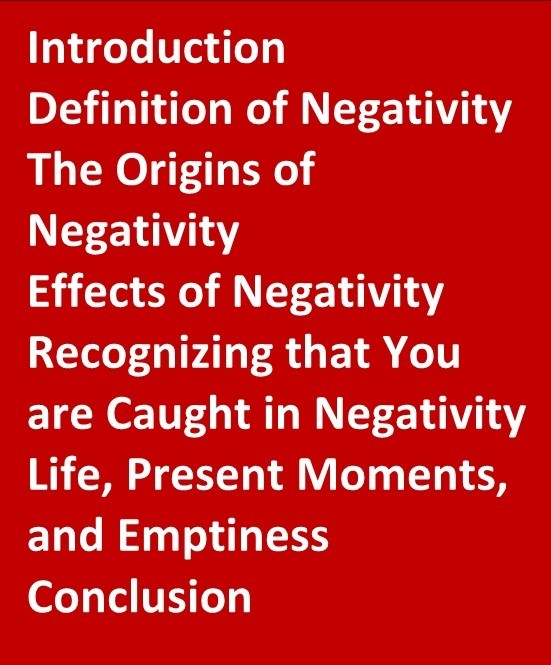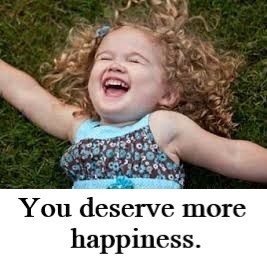Negativity: Definition, Origin, and Effects
INTRODUCTION
In the August Letter we considered the issue of the glass half full/glass half empty approaches to life. We hinted that glass half empty people are at risk of slipping into negativity. In this Letter we will further investigate the vulnerabilities of half empty people, but actually the vulnerabilities that all of us have toward becoming excessively negative in our experience of life.
An important idea: We will discuss beliefs, attitudes, expectations for the future, thoughts, and feelings. Beliefs are fundamental. Everything starts with beliefs. They then give rise to attitudes, expectations for the future, thoughts, and feelings.
DEFINITION OF NEGATIVITY
Both the positive and negative are part of life. They are two opposite poles. In order to have balance in life and to live effectively, we need the positive and the negative. Positive is saying “yes.” Negative is saying “no.” “Yes” words are allowing, accepting, opening, welcoming, while “no” words are refusing, rejecting, closing, repelling. We move toward “yes” and away from “no.” As emotions the positive is experienced as pleasurable and the negative is experienced as painful. As feelings, both pleasure and pain are essential as they both send us important messages about our life and about ourselves. Negativity is about saying “no” when “yes” is necessary or saying “no” more frequently and intensely than is necessary. Our moment to moment experience of negativity is feeling unnecessary pain and discomfort, or the numbness which is the absence of pleasure. (We are making a distinction between negative (which stands in relation to the positive) and the negativity that poisons our enjoyment of life. However in the following discussion we use the word negative to mean the negative of negativity.)
Point of Empowerment: Negativity is defined as having an excessive and/or persistent negative orientation toward life. This orientation generates an excessive and/or persistent amount of painful life experiences.
Our orientation toward life is created by our beliefs, attitudes, expectations for the future, thoughts, and feelings. A negative orientation is caused by excessive amounts of negative beliefs, attitudes, expectations, thoughts, and feelings. Here are some examples of unnecessary “no” saying and the beliefs behind the “no.”
- Can you be happier than you are? “No, I don’t deserve it. I believe in my lack of desirability.”
- Can you be more successful that you are? “No, I cannot be more successful than my parents. I believe that to love my parents is to not be more successful than they are.”
- Can you earn more money than you do now? “No, I am not smart enough. I believe that I am not good enough.”
- Can you be a better parent than you are now? “No. I was abused or unhappy as a child and can’t do better. I believe that my abuse or unhappiness limits me.”
- Can you feel better than you do now? “No, I believe that life is full of pain and struggle. My life works according to my belief, which is the way it should be. I won’t change how I feel because this is who I am.”
Point of Empowerment: Seek a balanced life that has more “yes” in it than “no.” The proportion of “yes” to “no” can range from 51% yes/49% no to 70% yes/30% no.
We have core, intermediate, and operational beliefs. Core beliefs are the foundations we build on. Intermediate beliefs refer to general areas of life. Operational beliefs refer to a specific situation. Core beliefs give rise to core attitudes and expectations for the future, which give rise to specific thoughts and feelings about a situation.
Consider these examples.
- Belief: life is a struggle. Attitude: pessimism. Expectation/thought about a specific situation: “My boss will not give me what I want without a struggle, without a fight.” Feeling: angry and defensive. Angry and defensive feelings give rise to angry and defensive behavior which provokes angry and defensive behavior from my boss. His behavior confirms my belief that life is a struggle.
The flow is: “Life is a struggle, work is a struggle, I am having a conflict/struggle with my boss at this moment in time. You see, life is a struggle.” This is also an example of getting caught in self-perpetuating vicious circles that start with a belief and end with reinforcing the belief.
A contrasting approach could be:
- Belief: life brings me what I need, want, and desire. Attitude: optimism. Expectation: since my work is fulfilling, I look for pleasure, enjoyment, and growth there. Each day brings something pleasurable, though there is also conflict with others at times. My boss and I get along well most of the time. Occasional conflict gets resolved in a productive or at least reasonable, manner.
THE ORIGIN OF NEGATIVITY
There are many causes for excessively negative beliefs, attitudes, expectations, thoughts, and feelings. One important cause of a negative orientation to life are the beliefs and attitudes that we learned from our parents and family. Our father told us, “Life is full of hardship, enjoy what little there is of happiness.” Or we observed our mother frequently crying and concluded that life is full of sadness that you can’t escape.
Another cause of negativity are the traumatic experiences that we have gone through. As the result of extremely painful experiences or less intense but chronically painful experiences, we form beliefs such as, “The world is a dangerous place. To survive you need to hide.” Or “people that are supposed to love you or care about you can’t be trusted.” These are the beliefs that we carry forward and that result in negativity.
(For a full exploration of the origins and functions of beliefs see the April 2018 Letter. In the May 2018 Letter you can read more about identifying what beliefs you have.)[i]
EFFECTS OF NEGATAIVITY
There are many effects of negativity. Some of these are:
- Being a glass half full person
- Frequent painful feelings
- Pessimism—negative expectations for the future
- Over focusing on negative/painful events and on the negative aspects of life in general
- Frequent moods of sadness and unhappiness
- Habitual self-criticism and self-blaming
- Having an inner emotional climate of gloom and doom
- Saying “No” (instead of “yes”) as your first response to something new
- Missing opportunities for happiness, joy, and fulfillment
- Feeling discouraged and disheartened
- Vulnerability to depression and anxiety
- Physical illness
- Having conflictful and unsatisfying relationships
- Creating distortions to our perceptions
- Creating distortions in our abilities
RECOGNIZING THAT YOU ARE CAUGHT IN NEGATIVITY
Here are two methods that you can use to recognize that you are caught in negativity.
Go through the effects of negativity and see if you are experiencing them in intense, and/or frequent, and/or persistent ways.
Use the new analytic matrix (August 2017 Letter)[ii] to recognize negativity. Remember that the negative and positive are both part of life. The matrix provides an analytical tool to decide whether or not you have too much negative in your life. There is a chart with use, misuse, and abuse on the top row and right amount, more, too much, less, and too little on the side. Run negative attitudes, expectations, thoughts, and feelings through the chart to discover if you have too much negative and therefore negativity in your life.
Practice: Seek the courage that is necessary to investigate the negativity that is in your life.
LIFE, PRESENT MOMENTS, AND EMPTINESS
In the August 2019 Letter we described some of the negative aspects of being a “glass half empty” person and related it to our ability to sense what is missing in life. We want to explore this further and connect this month’s and last month’s Letters. Last month we had presented some ideas about living life that we want to restate and modify a little bit.
- The “next present moment” of our life is empty and waits for us to fill it. What we fill it with is a choice. Freedom lies within this choice.
- Since human beings are capable of sensing what is missing in the emptiness, we can see what we need to enrich and enhance our life.
- Sometimes we fill the emptiness of the “next present moment” with what will make our life better.
- However, we often fill the emptiness with our fears or with something negative that comes from our negativity. (Glass half empty people do this more often than glass half full people.)
- Filling the emptiness with our negativity causes us unnecessary pain and robs us of some of the pleasure in life.
Point of Empowerment: A profound effect of negativity is the distortion of the ability we have as human beings to sense what is missing, missing in a situation and missing in our life.
One distortion, for example, are fears that cause us to avoid perceiving moments of emptiness and to rush through them. In the rushing we lose our ability to sense what is missing. We may have a fear that we won’t get what we want in life. This can be a deep seated fear generated by many experiences of not getting what we wanted and the painful frustration that we felt. Negativity over focuses on those experiences and feelings. Also, we may believe that “There is not enough to go around, and therefore I will not get what I want.” Since noticing what is missing scares us, we may fill the emptiness with the first thing that comes to mind, which can be a habitual negativity. Some examples:
- I feel little affection from my spouse though I want it. Don’t fill these moments with anger or depression, but recognize what is missing, and fill it with what you need, some form of love.
- My son is sick so I had to cancel the fun activities we planned for the day. I am very frustrated and very angry and “wallowing”—stuck in negativity. Learn to moderate your frustration and anger and make alternative fun plans.

Practice: Create a balanced approach to life by acknowledging the frustrating experiences of not getting what you want along with all the satisfying and pleasurable times where your desires were fulfilled.
CONCLUSION
We have been discussing various aspects of negativity. In the next Letter we will consider approaches to end negativity. Hopefully we have inspired you to start a process that will change your life. You can’t do it all at once, but as you start the process of change you will immediately experience some of the rewards that change brings.
[i] April 2018 Defining Beliefs, https://iifsd.org/library/newsletters/april-2018-letter/
May 2018 Identifying Beliefs, https://iifsd.org/library/newsletters/may-2018-letter/
[ii] Aug. 2017 The New Analytical Matrix, https://iifsd.org/library/newsletters/august-2017-newsletter/
